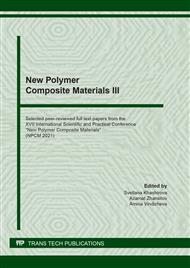[1]
Gilhotra, C., M. Chander, and Sanjay. A review: Conducting polyaniline polymer., AIP Conference Proceedings. Vol. 2142. No. 1. AIP Publishing LLC, (2019).
DOI: 10.1063/1.5122557
Google Scholar
[2]
Gawri, Isha, et al. Synthesis and characterization of polyaniline as emeraldine salt., AIP Conference Proceedings. Vol. 1728. No. 1. AIP Publishing LLC, (2016).
DOI: 10.1063/1.4946338
Google Scholar
[3]
Bhadra, Jolly, Asma Alkareem, and Noora Al-Thani. A review of advances in the preparation and application of polyaniline based thermoset blends and composites., Journal of Polymer Research 27.5 (2020): 1-20.
DOI: 10.1007/s10965-020-02052-1
Google Scholar
[4]
MacDiarmid, Alan G. "Synthetic metals": a novel role for organic polymers., Current applied physics 1.4-5 (2001): 269-279.
DOI: 10.1016/s1567-1739(01)00051-7
Google Scholar
[5]
Llorens, Elena, et al. Nanomembranes and nanofibers from biodegradable conducting polymers., Polymers 5.3 (2013): 1115-1157.
DOI: 10.3390/polym5031115
Google Scholar
[6]
Bogomolova, O., et al. Memristors based on Polyaniline-Nafion interpolyelectrolyte complexes., AIP Conference Proceedings. Vol. 1479. No. 1. American Institute of Physics, (2012).
DOI: 10.1063/1.4756552
Google Scholar
[7]
Berzina, Tatiana, et al. Electrochemical control of the conductivity in an organic memristor: a time-resolved X-ray fluorescence study of ionic drift as a function of the applied voltage., ACS Applied materials & interfaces 1.10 (2009): 2115-2118.
DOI: 10.1021/am900464k
Google Scholar
[8]
Berzina, T. S., et al. Investigation of electrical properties of organic memristors based on thin polyaniline-graphene films., Russian Microelectronics 42.1 (2013): 27-32.
DOI: 10.1134/s1063739713010022
Google Scholar
[9]
Budaev, Artem V., Roman N. Belenkov, and Nikita A. Emelianov. Memristive Properties of PANI-Polysterene/PVDF-TrFE Interface., Condensed Matter 4.2 (2019): 56.
DOI: 10.3390/condmat4020056
Google Scholar
[10]
Ameduri, Bruno, and Sergey Fomin, eds. Fascinating Fluoropolymers and Their Applications. Elsevier, (2020).
Google Scholar
[11]
Kochervinskii, Valentin V. The properties and applications of fluorine-containing polymer films with piezo-and pyro-activity., Russian Chemical Reviews 63.4 (1994): 367.
DOI: 10.1070/rc1994v063n04abeh000090
Google Scholar
[12]
Martins, P., A. C. Lopes, and S. Lanceros-Mendez. Electroactive phases of poly (vinylidene fluoride): Determination, processing and applications., Progress in polymer science 39.4 (2014): 683-706.
DOI: 10.1016/j.progpolymsci.2013.07.006
Google Scholar
[13]
Salimi, A., and A. A. Yousefi. Analysis method: FTIR studies of β-phase crystal formation in stretched PVDF films., Polymer Testing 22.6 (2003): 699-704.
DOI: 10.1016/s0142-9418(03)00003-5
Google Scholar
[14]
Liu, Fu, et al. Progress in the production and modification of PVDF membranes., Journal of membrane science 375.1-2 (2011): 1-27.
Google Scholar
[15]
Xia, Weimin, et al. Dependence of dielectric, ferroelectric, and piezoelectric properties on crystalline properties of p (VDF‐co‐TrFE) copolymers., Journal of Polymer Science Part B: Polymer Physics 50.18 (2012): 1271-1276.
DOI: 10.1002/polb.23125
Google Scholar
[16]
Fukada, Eiichi. History and recent progress in piezoelectric polymers., IEEE Transactions on ultrasonics, ferroelectrics, and frequency control 47.6 (2000): 1277-1290.
DOI: 10.1109/58.883516
Google Scholar
[17]
Budaev, Artem V., et al. Current-voltage characteristics of phase boundaries PVDF-TrFE (70/30)/PANI nanocomposite., IEEE Transactions on Dielectrics and Electrical Insulation 27.5 (2020): 1395-1399.
DOI: 10.1109/tdei.2020.008449
Google Scholar
[18]
Güthner, P., and K. Dransfeld. Local poling of ferroelectric polymers by scanning force microscopy., Applied Physics Letters 61.9 (1992): 1137-1139.
DOI: 10.1063/1.107693
Google Scholar
[19]
Sharma, Pankaj, et al. High-resolution studies of domain switching behavior in nanostructured ferroelectric polymers., Nano letters 11.5 (2011): 1970-1975.
DOI: 10.1021/nl200221z
Google Scholar
[20]
Ahn, Yoonho, and Jong Yeog Son. Enhanced ferroelectric properties of P (VDF-TrFE) thin films from Nb nanopin electrodes., Polymer 180 (2019): 121696.
DOI: 10.1016/j.polymer.2019.121696
Google Scholar
[21]
Sharma, Pankaj, et al. Nanoscale domain patterns in ultrathin polymer ferroelectric films., Journal of Physics: Condensed Matter 21.48 (2009): 485902.
DOI: 10.1088/0953-8984/21/48/485902
Google Scholar
[22]
Kholkin, A. L., et al. Review of ferroelectric domain imaging by piezoresponse force microscopy., Scanning probe microscopy. Springer, New York, NY, 2007. 173-214.
DOI: 10.1007/978-0-387-28668-6_7
Google Scholar


